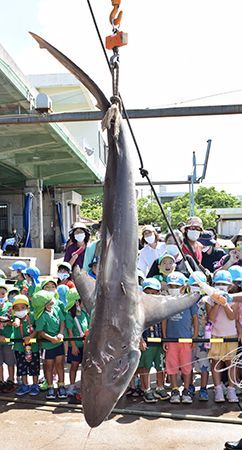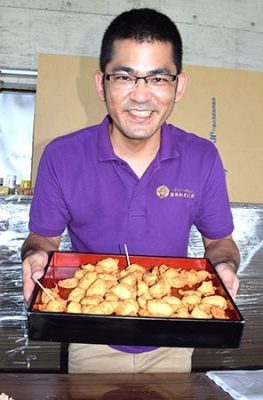Fishing village exterminates 145 sharks in effort to prevent damage to fishing hauls July 18, 2020 Ryukyu Shimpo

Spectators gather around to watch the sharks being unloaded. July 14, Ishigaki Harbor
July 18, 2020 Ryukyu Shimpo
Ishigaki – Fishermen from Ishigaki engaged on a two-day shark hunt on July 13 and 14 in the ocean around Ishigaki island. Over the course of the two days, they caught a total of 145 sharks, including species such as tiger sharks, silvertip sharks, and tawny nurse sharks.
On July 14 the captured sharks were unloaded one-by-one at Ishigaki harbor, including the largest, a 358 kilogram, 367 centimeter-long tiger shark. Local nursery school children and tourists who came to watch the unloading reacted in surprise to the sharks with comments like “It’s so big” and “scary.”
Yoshio Miyasato, the president of the Yaeyama Fisherman’s Cooperative pole fishing research council, one of the groups in the city’s fishing village, said, “With the price of fish slumping, the damage caused by sharks has become an increasingly severe problem. There have been many indicators this year of the damage. This hunt will have an effect for around 2 weeks. If we had the budget, I would like to do this around five, six times per year.
Want a taste? A food sampling booth that made kamaboko using a captured shark gets high praise for their tasty treat
Ishigaki – At the Yaeyama Fisherman’s Cooperative’s lot in Ishigaki harbor, where the captured sharks were unloaded on July 14, you can have a taste of kamaboko made with fresh shark meat at a tasting booth. Spectators and fishermen alike enjoyed snacking on the peculiar treat.

Kinjo Kamaboko CEO Kyuji Kinjo showing off his kamaboko made with tiger shark – Yaeyama Fisherman’s Cooperative
The tasting booth is run by Kinjo Kamaboko (Ishigaki Kamaboko), and the kamaboko was made using a tiger shark caught on July 13. According to CEO Kyuji Kinjo, 42, it was his first time making them.
In the food sampling corner set up in the fishing cooperative’s lot, both spectators and fishermen visited to try a bite of the shark-based kamaboko. The food got good reviews with feedback like, “It doesn’t stink” and “It’s tasty.”
Kinjo said, “It is pretty close to regular kamaboko. I think it can be used to dispel the bad image of sharks that they smell or are scary.”
(English translation by T&CT and Sam Grieb)
Previous Article:Residents near U.S. bases ask for PCR testing as coronavirus spreads among U.S military personnel
Next Article:OIST and HabuBox collaborate on kariyushi capsule collection
[Similar Articles]
- Churaumi Aquarium hosts world-first tiger shark birth from captive breeding
- Leatherworker Kinjo receives praise throughout Japan: turning sharkskin into appealing products like wallets and bags
- Baby saw sharks born at Okinawa Churaumi Aquarium
- “Jaws” in Okinawa Churaumi Aquarium dies after three days in captivity
- Biggest tuna caught in Ishigaki
 Webcam(Kokusai Street)
Webcam(Kokusai Street)


